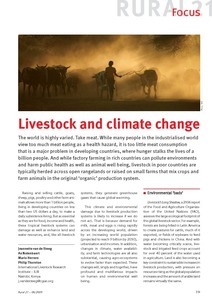The drylands of Africa, exclusive of hyper-arid zones, occupy about 43 per cent of the continent, and are home to a rapidly growing population that currently stands at about 325 million people. Dry zones, inclusive of hyper-arid lands, cover over 70 per cent of the continent’s terrestrial surface. Outside of the cities many dryland inhabitants are either pastoralists, sedentary or nomadic, or agro-pastoralists, combining livestock-rearing and crop production where conditions allow.
Search results
Showing items 1 through 9 of 9.-
Library ResourceManuals & GuidelinesReports & ResearchNovember, 2009Global
-
Library ResourceManuals & GuidelinesNovember, 2009Kenya, Eastern Africa
This paper evaluates the effectiveness of a new index-based livestock insurance (IBLI)
product designed to compensate for area average predicted livestock mortality loss in
northern Kenya, where previous work has established the presence of poverty traps. We
simulate household-specific wealth dynamics based on a model parameterized using rich
panel and experimental data from the region. The simulations allow us to investigate
patterns of willingness to pay for asset index insurance that is imperfectly correlated with
-
Library ResourceJournal Articles & BooksNovember, 2009Uganda, Eastern Africa
The traditional lifestyle of nomadic pastoralists is vanishing rapidly, because of human population growth which often leads to land scarcity or political pressure on pastoralists to settle. The sedentarisation of the Bahima pastoralists in Western Uganda started in the 1940s and is still going on. In this study former nomadic cattle keepers, who have settled with their families, were interviewed in order to document the decision to settle and the subsequent changes in the lifestyle of these people. All interviewees expressed their satisfaction with their sedentary life.
-
Library ResourceReports & ResearchNovember, 2009Africa, Eastern Africa
During the past 70 years, concerted efforts by the national veterinary services of affected countries from Senegal to China and Russia to South Africa—aided by international organizations—have brought the once-dreaded rinderpest virus to the point of extinction. In the near future, we can expect to see a global declaration of freedom from rinderpest, the first time this has been achieved for a livestock disease. The devastation wrought by rinderpest stimulated the founding of veterinary schools in many countries, and provided the basis for the development of the veterinary profession.
-
Library ResourceReports & ResearchNovember, 2009Ethiopia, Eastern Africa
PN37 (Increasing Water-Use Efficiency for Food Production through Better Livestock Management -
The Nile River Basin) set out to improve food security, reduce poverty and enhance agroecosystem
health by managing livestock for more effective overall use of water. PN37 responded to water
challenges posed by the CPWF, to the Nile Basin Initiative’s goal of better sharing benefits of water
use, and to global need for the livestock sector to use agricultural water more efficiently and
-
Library ResourceJournal Articles & BooksNovember, 2009Ethiopia, Africa, Eastern Africa
A flock monitoring study on 60 households as undertaken from October 2008 to September 2009 to measure productive and reproductive performances; determine socioeconomic benefits and husbandry practices; and identify production barriers and suggest intervention options in Alaba Special Woreda. The Woreda was stratified on the basis of sheep and goat densities and the respective sites and households were selected using multistage (purposive and random) sampling techniques. Mean land holding per household was 1.5 ha.
-
Library ResourceJournal Articles & BooksNovember, 2009
Raising and selling farm animals allows more than 1 billion people to make a daily subsistence living. But as essential as they are for food, income and health, these tropical livestock systems can damage as well as enhance land and water resources, and, like all livestock systems, they generate greenhouse gases that cause global warming. Research is helping poor livestock communities adapt to climate change, find sustainable ways to intensify their production, and, where possible, adopt methods to mitigate livestock-induced climate change.
-
Library ResourceManuals & GuidelinesNovember, 2009
-
Library ResourcePolicy Papers & BriefsDecember, 2009Portugal, Greece, Tunisia, Spain, Luxembourg, China, Italy
This guidelines booklet is addressed to the LADA partner countries and, more in general, to the increasing number of countries which are expressing their interest in implementing the LADA approach for mapping Land Degradation. The specific objective is to provide guidelines for the identification, selection and description of nationally based indicators of land degradation. The LADA approach is well defined by a range of specific documents and manuals. The National indicators common to all countries are based on the LADA-Wocat QM manual.
Land Library Search
Through our robust search engine, you can search for any item of the over 64,800 highly curated resources in the Land Library.
If you would like to find an overview of what is possible, feel free to peruse the Search Guide.








